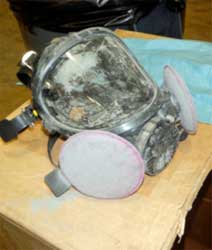Respirator Protection
Respiratory hazards in the workplace should be controlled whenever possible using engineering, work practice, or administrative controls. However, if these controls are not feasible or do not provide sufficient protection, employees may need to utilize respiratory protection.

Respirator Basics:
-
Respirators must always be inspected prior to donning.
o Theinspectionshouldcheckformissingorwornrespiratorparts. -
For air-purifying respirators, the proper cartridge or filter must be selected based on the hazard.
-
Respirator users must don the respirator properly and verify a good fit by performing positive and negative user seal checks each time the respirator is donned.
-
Respirator users must know the limitations of their respirator and stay clean shaven in the respirator seal area.
-
Employees may not share respirators and must only use the respirator for which they have been fitted.
- Respirators must be cleaned and stored properly after each use.
Safe procedures:
-
Positive Pressure Check: Close off the exhalation valve with the palm of your hand. Exhale gently. The fit is good if you can build up a slight positive pressure, without leaks, inside the face piece.
-
Negative Pressure Check: Close off the inlet of the cartridges by covering them with the palm of your hands. If you can’t close them off with your hand, a latex or nitrile glove may be used. Inhale gently so the respirator collapses slightly and hold your breath for 10 seconds. The fit is good if no air leaks into the respirator.
If leaks are detected, you need to adjust the fit. You may have to tighten the straps, remove obstructions (such as hair), shave, or talk to your supervisor about getting a different style or size of respirator.
“Save Your Breath… Wear Your Respirator”
Download flyer: STOTW_36_RespiratorProtection.pdf (93.16 kb)

